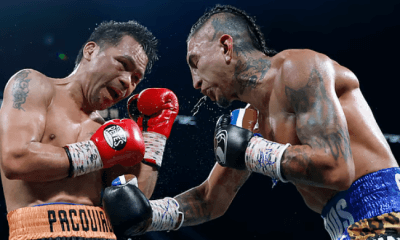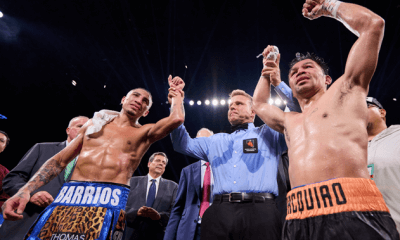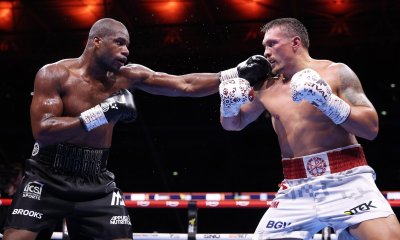Articles of 2008
Some Fantasies Come Without Sweat
When you stop and think about it, sports are inherently unfair, biased as they are against the short, slow, uncoordinated, paunchy and weak. Hey, we all want to be the guy who hits the walk-off homer in the seventh game of the World Series, drops 50 on Kobe Bryant in the NBA Finals, outduels Tiger Woods in the final round of the U.S. Open or knocks Wladimir Klitschko or Oscar De La Hoya stiff in a pay-per-view main event that does two million buys.
But undistinguished genetics (why couldn’t Mom and Dad have been Olympic gold medalists?) conspire against the vast majority of we sports-loving individuals, so we are reduced to living out our dreams through designated heroes who were more favorably kissed by nature. We settle for being fans … mere spectators rather than participants.
And that’s OK, I guess. If you’re a middle-aged fat guy with 5 o’clock shadow who loves the Washington Redskins, you put on a frumpy dress, oversized hat, dime-store pearls and a plastic pig’s snout, the better to convince yourself that being a Hogette is just as much fun as running through an NFL defense like Clinton Portis.
But some people aren’t satisfied to just sit and cheer. They need to mentally transport themselves into the ring or onto the field. And that requires more than mere imagination. It requires props.
There are entrepreneurs out there who make a very handsome living offering us ways and means to artificially slip inside the personas of the athletes we admire. For fees ranging from $50 or so to the high four figures, we can be that guy.
One of the first adventurers into the area of dream fulfillment was Harvard-educated writer George Plimpton, who physically resembled Ichabod Crane and spoke with the measured intellectualism of the Ivy League egghead that he was. Plimpton, who was 66 when he died in 2003, made a name for himself with something that came to be known as “participatory journalism.” He probably was best known for his book, “Paper Lion,” that detailed his 1963 training-camp experiences as a backup quarterback with the Detroit Lions (it was adapted into a 1968 movie starring Alan Alda as Plimpton), but he also pitched to the 1960 National League All-Star team, briefly played goalie in an exhibition game for the Boston Bruins and sparred three rounds apiece with Archie Moore and Sugar Ray Robinson while on assignment for Sports Illustrated. Try as he might to go easy on Plimpton, the Mongoose still drew blood.
Full disclosure: I once dabbled in participatory journalism myself. During a practice session for a World Championship Tennis tour stop in Jackson, Miss., I attempted to return several of Roscoe Tanner’s 145-mph bullet serves. Whiff, whiff, whiff, whiff. But, really, can you blame me for failing to put a racket on even one ball? It was hard enough concentrate on returning serve against a onetime Wimbledon finalist, but try doing so while using your free hand to protect your gonads.
Perhaps inspired by Plimpton’s antics, the Los Angeles Dodgers in 1983 launched their first “Fantasy Baseball Camp” at the team’s spring-training facility in Vero Beach, Fla. For a couple of grand, well-heeled fans went to Dodgertown in early November where for a week they played alongside and were instructed by several of the team’s retired greats. Campers were issued uniforms, which they got to keep, with their names stitched onto the back. Pretty neat.
Other major league teams quickly followed the Dodgers’ lead, and pretty soon “fantasy camps” were popping up all over. The Los Angeles Lakers enlisted some former players to school YMCA wannabes who dared to believe their low-vertical-leap jump shots were of Jerry West-quality. Some years back, I think someone even came up with the idea for a rock ’n’ roll fantasy camp where normal people could prance around on stage like Mick Jagger, strum at stringless electric guitars and sing, badly, into microphones as strobe lights and pyrotechnics flashed around them.
Take that, “American Idol.”
Of course, all of these camps are guaranteed to considerably lighten one’s wallet. But there are low-price options for the frugal. Next time you fly anywhere, check out the complimentary SkyMall book in the seat pocket in front of you. Among the items for sale you’re apt to find are a photograph of a baseball player, his back to the camera, arriving as home plate as a mob of his jubilant teammates greet him after a game-winning home run. That same photo can be ordered with your name prominently displayed on the back of the jersey.
There also was an entrepreneurial sports announcer, whose name I can’t quite recall, who profited handsomely through the production of 5-minute audiocassettes in which paying customers became the stars of the faux action. The announcer not only supplied the stentorian tones, but crowd noise, sound effects, whatever someone wanted. If your fantasy was to smash Muhammad Ali or George Foreman into so much tapioca pudding, so be it. On one tape, a blind man took the checkered flag at the Indianapolis 500 as his guide dog, seated beside him, barked instructions.
Given all that had gone before, it was inevitable that someone conceive of a “fantasy boxing camp” where accountants, attorneys and other reasonably normal people could unleash the inner tough guy they long had imagined lurked within themselves.
Bruce Silverglade, proprietor of the famous Gleason’s Gym in Brooklyn, N.Y., already was providing, for a monthly fee, white-collar boxing training for clients who over time had come to provide more of his operating income than actual pros. Why not expand upon the concept? So in 2003 Silverglade opened his first 3½-day camp, at Kutsher’s Country Club in the Catskills, a Borscht Belt resort that once served as the training camp to such renowned champions as Rocky Marciano and Emile Griffith.
This year’s sixth annual bash, which was held in September, invited awestruck campers to turn themselves over to such celebrity instructors as Griffith, Carlos Ortiz, Mark Breland, Iran Barkley, Juan LaPorte and Yuri Foreman.
The 40 or so campers, some of whom came from as far away as Australia, England and Germany, rose early to do roadwork and throughout the day they shadowboxed, worked the heavy and speed bags and did everything a real fighter would do if he was getting ready for a bout. Well … they might not have done it quite so long or so intensely, but then allowances must be made for those who no longer are at the top of their game, or perhaps never were.
On the final night, campers were paired by size, age and experience level in three-round sparring sessions that were enthusiastic, if not necessarily tutorials of technical expertise. Despite the headgear and pillow-sized gloves, a few of the combatants came away with fat lips and bloody noses.
Like John Mellencamp might have sung, sometimes it really does hurt so good.
But what do you do if you’re not into sweat and pain? What if you require an up-close-and-personal boxing fix, but your creaky body won’t cooperate? What if you want to be more like Don King than Mike Tyson?
In that case, you’re in luck. There is an avenue to become a behind-the-scenes wheeler-dealer, a veritable master of trickeration. It’ll cost you, sure, but remember, this is boxing. Everybody pays up sooner or later.
“Fight Promoter University” is the brainchild of Roy Englebrecht, and its curriculum purportedly prepares students to enter the wild ’n’ wooly world of boxing promotion. Take a few classes, apply for a license with your friendly state commission and voila! You’re ready to stage your own shows, the first step toward rubbing elbows with King, Bob Arum, Richard Schaefer, Kathy Duva, Gary Shaw and other of the sport’s more recognizable power brokers.
The next logical step in boxing’s fantasy process, I’d venture, would be for such seasoned flacks as Fred Sternburg, Ed Keenan, Norman Horton and Kelly Swanson to serve as faculty members for “Boxing Publicists’ Camp,” which would include courses that even I might get a kick out of monitoring. Said courses might include:
— “Writing a six-page press release about a King-promoted card,” in which the first 5½ pages are devoted to gushing praise of His Hairness, and the last half-page to the actual boxers. If space is limited, reduce the number of mentions of the fighters.
— “How to laugh at boxing writers’ jokes even when they aren’t funny.” The key to being a great PR person is to flatter the hell out of media members whose stories on your event might ensure your future employment.
— “Coping with enraged members of the media.” Flattery can only take you so far when confronted by writers who were denied access to the press section because some of the prime seats are occupied by blonde, cleavage-showing girlfriends of television executives or other well-connected VIPs.
— “Rescheduling teleconferences.” A must when dealing with fighters like Tyson and Roy Jones Jr., who don’t always get on the line for these group exercises in tedium when they’re supposed to, if they get on at all. Must be able to instantly manufacture semi-plausible excuses for the principals’ tardiness or absenteeism.
— “Culinary Arts 101.” Nothing appeases media members more than free food, and lots of it. If all else fails, make sure the press room is well-stocked with Dove bars and chicken fingers.
Well, that’s about it for now. I have to send in my check for that photo-shopped picture of me accepting the Pulitzer Prize.
-

 Featured Articles3 weeks ago
Featured Articles3 weeks agoThe Hauser Report: Zayas-Garcia, Pacquiao, Usyk, and the NYSAC
-

 Featured Articles2 weeks ago
Featured Articles2 weeks agoOscar Duarte and Regis Prograis Prevail on an Action-Packed Fight Card in Chicago
-

 Featured Articles1 week ago
Featured Articles1 week agoThe Hauser Report: Cinematic and Literary Notes
-

 Book Review5 days ago
Book Review5 days agoMark Kriegel’s New Book About Mike Tyson is a Must-Read
-

 Featured Articles4 weeks ago
Featured Articles4 weeks agoManny Pacquiao and Mario Barrios Fight to a Draw; Fundora stops Tim Tszyu
-

 Featured Articles4 weeks ago
Featured Articles4 weeks agoArne’s Almanac: Pacquiao-Barrios Redux
-

 Featured Articles3 weeks ago
Featured Articles3 weeks agoRemembering Dwight Muhammad Qawi (1953-2025) and his Triumphant Return to Prison
-

 Featured Articles4 weeks ago
Featured Articles4 weeks agoOleksandr Usyk Continues to Amaze; KOs Daniel Dubois in 5 One-Sided Rounds













